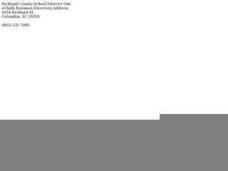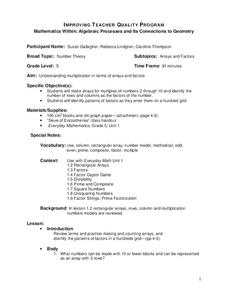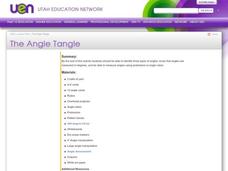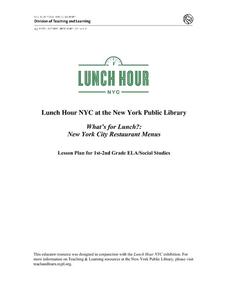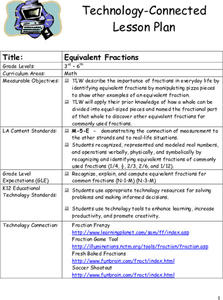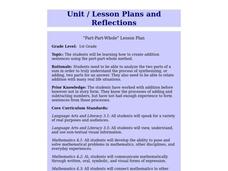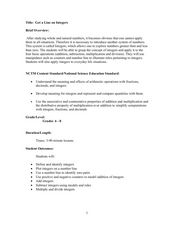Noyce Foundation
Building Blocks
Building blocks have more uses than simply entertaining children. Young mathematicians calculate the volume of a given cube, and then calculate the volume and surface area of a prism formed from multiple cubes.
EngageNY
Choice of Unit
Explore using units with scientific notation to communicate numbers effectively. Individuals choose appropriate units to express numbers in a real-life situation. For this 13th lesson of 15, participants convert numbers in scientific...
K12 Reader
Basic Geometry Terms
Set your pupils up to start on geometry by teaching them some introductory terminology. Pupils learn the terms by reading a short passage and looking at examples. They then respond to five questions related to the text.
Curated OER
Kernel Count!
Here is an impressive and thorough lesson on estimation. Young mathematicians estimate how many kernels of popcorn can fit in a tablespoon, then how many tablespoons of kernels can fit in a baby food jar. The popcorn is then popped. All...
Curated OER
Investigating Shapes in Our World
First graders explore shapes. In this geometry lesson, 1st graders make shapes with geo-boards, use play-dough to make three-dimensional figures, and make a shape book using pre-cut shapes.
Curated OER
Fractions in the Kitchen
Seventh graders use the World Wide Web for research, identify fractions found in everyday life by finding a recipe that uses fractions.
Curated OER
Mathematics Within: Algebraic Processes and Its Connections to Geometry
Fifth graders discover the connections between algebra and geometry. With a focus on arrays and factors, they are introduced to multiplication. They develop an array for multiples of 2 through 10 and identify the factors of each row....
Curated OER
Seeing Numbers In Tens And Ones
Second graders develop the skill of place values up to the tens place. They practice identifying the values of 2 digit numbers and writing the correlating values with counting. They use the example of money to make the lesson more...
Curated OER
Angles
Fourth and fifth graders investigate angles and name them according to the criteria for obtuse, acute, and right angles. They examine a human-made yarn pattern on the floor of their classroom and identify angles, vertices, and types of...
New York Public Library
What's for Lunch?: New York City Restaurant Menus
Do you remember the days when a cup of coffee cost five cents? At A.W. Dennett restaurant in 1894, you could buy a five-cent cup of coffee and as well as a five-cent slice of pie to accompany it. The menu from that year is a primary...
Curated OER
Writing in Math Class
Students brainstorm and discuss ways math is all around them, explain in writing how they solve math problems, describe mathematical ideas in writing, and create original story problems.
Curated OER
Using the Correct Vocabulary to Solve Problems
Third graders examine the vocabulary and strategies to be used with addition, subtraction, and multiplication word and story problems. They observe the teacher solve a variety of problems, then write and illustrate their own original...
Curated OER
Equivalent Fractions
Learners describe importance of fractions in everyday life by identifying equivalent fractions and manipulating pizza pieces to show examples of equivalent fractions, and demonstrate knowledge of how whole can be divided into equal-sized...
Curated OER
My Test Book: Multiplication Story Problems
In this math skills learning exercise, students solve 10 multiple choice math problems that require them to multiply using decimals. Students may view the correct answers.
Curated OER
An Introduction to Simple Machines
Students investigate simple machines and their uses in everyday life. In this scientific method instructional activity, students examine physical tools such as wedges, screws, and levers using a "how does it work" approach....
Curated OER
My Test Book: Multiplication and Division
In this online interactive math skills worksheet, students solve 10 multiple choice math problems that require them to multiply and divide with 2-digit numbers. Students may submit their answers to be scored.
Curated OER
Terrific Tessellations
Students explore tessellations that are found in nature and everyday objects. They observe the works of M.C. Escher. Students create their own tessellations using pencil and paper.
Curated OER
Algebraic Processes And Its Connection To Geometry
Learners investigate the concept of polygons using a variety of activities. They explore the vocabulary of polygons by constructing a graphic organizer. Then students categorize the characteristics of several polygons and contribute the...
Curated OER
Going "Diggie" with Math Word Problems
Sixth graders create word problems. In this sixth grade mathematics activity, 6th graders use digital cameras to photograph interesting events around school and create word problems for their photographs that address the key concepts...
Curated OER
Part-Part-Whole
First graders work with partners, using cubes to make addition sentences. In this math lesson, 1st graders separate cubes into 2 parts and discuss the relationship to addition sentences. Students practice separating cubes. Students make...
Curated OER
Create Your Own Coded Language
Students discover and identify cryptology used in everyday life. They decipher or crack codes. Students create their own secret writing or coded messages, and develop a dictionary of eponyms. They discuss how they have already...
Curated OER
Get a Line on Integers
Middle schoolers explore number sense by completing math function problems in class. In this integers lesson, students define integers and practice plotting them on a number line. Middle schoolers utilize math functions such as addition...
Curated OER
Chart problems involving car defects and customer service departments
In this interactive activity, students solve two problems using the charts provided. Students must convey they are able to understand charts and how to read them.
Curated OER
Jack and the Beanstalk Estimation
Students use estimation and pencil-paper calculations to help Jack and his mother solve a variety of life problems. They solve problems using various math operations, i.e., addition, subtraction, and measurement.




